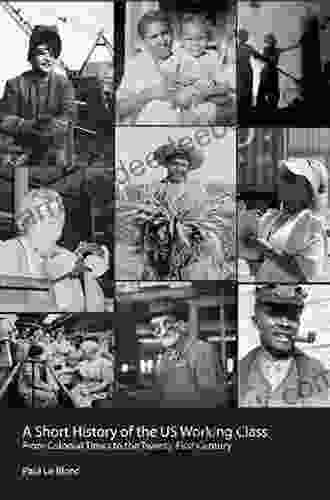A Comprehensive History of the Working Class: From Feudal Serfs to Modern Wage Laborers

The working class, broadly defined as the portion of society that earns its living through wage labor, has played a central role in human history. From the feudal serfs who toiled on the land to the modern factory workers who assemble our consumer goods, the working class has been the backbone of societies around the world.
4.3 out of 5
| Language | : | English |
| File size | : | 1825 KB |
| Text-to-Speech | : | Enabled |
| Screen Reader | : | Supported |
| Enhanced typesetting | : | Enabled |
| Word Wise | : | Enabled |
| Print length | : | 254 pages |
| Lending | : | Enabled |
Origins in Feudalism
The origins of the working class can be traced back to the feudal system that emerged in Europe during the Middle Ages. Under feudalism, the vast majority of the population was composed of serfs, who were bound to the land and obligated to work for their lord in exchange for protection and sustenance.
Serfs were not free to move or to choose their own work. They were essentially the property of their lord, who could sell or trade them as he saw fit. Serfdom was a harsh and oppressive system, but it did provide serfs with a degree of security in a time of great uncertainty and violence.
The Rise of Capitalism
The feudal system began to decline in the late Middle Ages, as trade and commerce grew and towns and cities began to flourish. This led to the rise of a new economic system, capitalism, which was based on the private ownership of property and the profit motive.
Under capitalism, workers were no longer bound to the land. They were free to move and to choose their own work, but they were also subject to the vagaries of the market. If there was no demand for their labor, they could be left unemployed and destitute.
The Industrial Revolution
The Industrial Revolution, which began in the late 18th century, transformed the working class in a profound way. New technologies, such as the steam engine and the power loom, led to the development of factories, where workers were concentrated in large numbers and subjected to a strict and disciplined regime of work.
Factory work was often dangerous and unhealthy, and workers were paid very low wages. They also had no job security, and could be fired at any time. The Industrial Revolution created a new class of industrial workers, who were often exploited and impoverished.
The Labor Movement
In the 19th century, workers began to organize themselves into labor unions to fight for better wages, working conditions, and job security. The labor movement played a key role in the development of the working class, and it helped to secure many of the rights and benefits that workers enjoy today.
The labor movement also played a role in the development of socialism and communism, which are political ideologies that advocate for the overthrow of capitalism and the establishment of a more egalitarian society.
The 20th Century
The 20th century was a time of great change for the working class. The rise of new technologies, such as the automobile and the computer, led to the development of new industries and the decline of others.
The working class also faced new challenges, such as globalization and the outsourcing of jobs to low-wage countries. These challenges have led to a decline in the share of national income going to workers in many developed countries.
The Future of the Working Class
The future of the working class is uncertain. Some experts believe that the working class will continue to decline in size and importance, as technology replaces human labor in more and more jobs.
Others believe that the working class will continue to play a vital role in the economy, but that it will need to adapt to the changing nature of work. They argue that workers will need to develop new skills and embrace lifelong learning in order to succeed in the 21st century economy.
Whatever the future holds, the working class has played a central role in human history, and it is likely to continue to do so for many years to come.
**Image with long descriptive alt attribute:**
[Image of a group of factory workers standing in front of a factory building]
Alt attribute: A group of factory workers, dressed in overalls and hard hats, stand in front of a large factory building. The factory is surrounded by smokestacks and industrial equipment. The workers are looking at the camera, and their expressions are a mix of pride and exhaustion.
4.3 out of 5
| Language | : | English |
| File size | : | 1825 KB |
| Text-to-Speech | : | Enabled |
| Screen Reader | : | Supported |
| Enhanced typesetting | : | Enabled |
| Word Wise | : | Enabled |
| Print length | : | 254 pages |
| Lending | : | Enabled |
Do you want to contribute by writing guest posts on this blog?
Please contact us and send us a resume of previous articles that you have written.
 Book
Book Text
Text Story
Story Genre
Genre Paperback
Paperback E-book
E-book Newspaper
Newspaper Sentence
Sentence Glossary
Glossary Bibliography
Bibliography Preface
Preface Synopsis
Synopsis Footnote
Footnote Scroll
Scroll Classics
Classics Library card
Library card Narrative
Narrative Biography
Biography Autobiography
Autobiography Memoir
Memoir Reference
Reference Dictionary
Dictionary Narrator
Narrator Resolution
Resolution Catalog
Catalog Archives
Archives Periodicals
Periodicals Study
Study Research
Research Scholarly
Scholarly Reserve
Reserve Academic
Academic Journals
Journals Rare Books
Rare Books Literacy
Literacy Dissertation
Dissertation Storytelling
Storytelling Reading List
Reading List Book Club
Book Club Textbooks
Textbooks Heidi Loney
Heidi Loney Laramie Briscoe
Laramie Briscoe John David Mann
John David Mann Roulhac Toledano
Roulhac Toledano Amanda Francis
Amanda Francis Helena Hunting
Helena Hunting Rose Kerr
Rose Kerr Nervana Elkhadragy
Nervana Elkhadragy Kerry Greenwood
Kerry Greenwood Alyxandra Harvey
Alyxandra Harvey James Chang
James Chang Rusel Demaria
Rusel Demaria Alessandro Parisi
Alessandro Parisi Moncef Berhouma
Moncef Berhouma John Warwicker
John Warwicker John Hope Bryant
John Hope Bryant Paul Poast
Paul Poast Lauro Martines
Lauro Martines Simon Beaufort
Simon Beaufort Bill Farr
Bill Farr
Light bulbAdvertise smarter! Our strategic ad space ensures maximum exposure. Reserve your spot today!

 Lee SimmonsUnveiling the Extraordinary Life and Impact of "The Peacemaker" - Docudrama...
Lee SimmonsUnveiling the Extraordinary Life and Impact of "The Peacemaker" - Docudrama... Ed CooperFollow ·10.6k
Ed CooperFollow ·10.6k Quincy WardFollow ·8.7k
Quincy WardFollow ·8.7k Rob FosterFollow ·12.2k
Rob FosterFollow ·12.2k Italo CalvinoFollow ·3.7k
Italo CalvinoFollow ·3.7k Brandon CoxFollow ·19.2k
Brandon CoxFollow ·19.2k Cooper BellFollow ·15.1k
Cooper BellFollow ·15.1k Barry BryantFollow ·19.8k
Barry BryantFollow ·19.8k Art MitchellFollow ·9.3k
Art MitchellFollow ·9.3k

 Abe Mitchell
Abe MitchellUnveiling the Urban Cheating Rich System: A Comprehensive...
In today's complex and ever-evolving urban...

 Preston Simmons
Preston SimmonsSelection, Processing, and Care of Reeds: A Comprehensive...
Reeds are essential...

 Rob Foster
Rob FosterKeeper of the Grail: The Youngest Templar
Prologue: A Sacred...
4.3 out of 5
| Language | : | English |
| File size | : | 1825 KB |
| Text-to-Speech | : | Enabled |
| Screen Reader | : | Supported |
| Enhanced typesetting | : | Enabled |
| Word Wise | : | Enabled |
| Print length | : | 254 pages |
| Lending | : | Enabled |
















